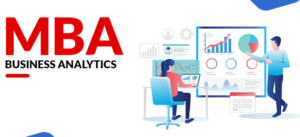Business Analytics for MBA Students – In today’s data-driven world, MBA students cannot afford to overlook the importance of business analytics. From streamlining decision-making to uncovering growth opportunities, analytics skills are key to succeeding in competitive business environments.
What is Business Analytics?

Business analytics involves leveraging data, statistical analysis, and predictive modeling to make informed business decisions. It combines technology, processes, and applications to evaluate past performance and plan for the future.
For MBA students, mastering business analytics tools provides:
- Enhanced decision-making skills through actionable insights.
- Career advancement opportunities in data-centric industries.
- The ability to drive business strategies effectively.
Benefits of Business Analytics Tools for MBA Students
Business analytics tools offer a wide range of advantages for MBA students. By integrating data analysis into their curriculum and career preparation, these tools provide crucial insights that enhance learning, decision-making, and problem-solving skills. Here are some key benefits:
1. Improved Decision-Making Skills
MBA students are often tasked with making business decisions based on complex data. Business analytics tools help them make informed, data-driven choices rather than relying on intuition alone.
These tools enable the analysis of vast datasets, offering insights that guide strategic decisions. For example, through advanced forecasting and trend analysis, students can make better financial, marketing, and operational decisions.
How it Helps:
- Analytics tools provide real-time insights, allowing students to quickly adjust strategies.
- Decision-making becomes more accurate and aligned with real-world business needs.
2. Enhanced Data Interpretation Skills
As business operations increasingly rely on data, being able to interpret complex data is an essential skill for MBA graduates. Business analytics tools equip students with the ability to understand and translate raw data into actionable insights.
Whether it’s interpreting financial reports, consumer behavior, or operational metrics, these tools transform abstract numbers into understandable visualizations and narratives.
How it Helps:
- Tools like Tableau and Power BI turn large datasets into interactive charts, graphs, and dashboards, making it easier for students to extract meaningful insights.
- Students can hone their analytical thinking and problem-solving abilities.
3. Greater Career Opportunities
In the job market, employers value candidates with strong analytical skills. By mastering business analytics tools, MBA students can differentiate themselves from others. These tools provide hands-on experience with the software widely used in the industry, making graduates more attractive to employers.
How it Helps:
- SAS Analytics and IBM Cognos are often used in large corporations. Familiarity with these tools gives students a competitive edge when applying for data-driven roles.
- Career opportunities in finance, marketing, consulting, and data science become more accessible.
4. Time Efficiency & Automation
Many business analytics tools offer automation features that allow students to quickly process and analyze large datasets without manual intervention. These tools can generate reports, automate calculations, and perform complex analysis with minimal effort.
This time-saving benefit allows students to focus more on strategic thinking and decision-making rather than spending hours on manual data manipulation.
How it Helps:
- Microsoft Power BI offers automated data refreshes and report generation, saving students hours of work.
- Students can handle larger datasets more efficiently, leading to better-quality projects and research outcomes.
5. Hands-on Learning and Real-World Application
Business analytics tools allow students to apply theoretical knowledge to practical scenarios. Whether it’s analyzing a company’s financial performance or creating a marketing strategy based on data, students can use these tools to simulate real-world business situations.
This hands-on experience is invaluable for their learning process and future career.
How it Helps:
- Students can simulate business challenges, such as market analysis, sales forecasting, and customer segmentation, using real company data.
- Practical applications deepen students’ understanding and provide more insight into how businesses operate.
6. Collaboration and Teamwork
Many modern business analytics tools are cloud-based, allowing students to work collaboratively on data projects.
This feature enhances teamwork and allows MBA students to engage in joint analysis, report generation, and presentation preparation in a seamless, remote environment.
How it Helps:
- Google Data Studio and Tableau allow multiple users to collaborate on the same project in real-time, ensuring efficiency in group assignments.
- Students can work together on business projects without the need for physical proximity.
7. Enhanced Data-Driven Strategy Development
Business analytics tools provide a structured way for MBA students to develop data-driven strategies. By analyzing customer data, market trends, and business performance, students can create evidence-backed strategies for business growth.
This approach is essential in today’s competitive business environment where decisions need to be backed by data.
How it Helps:
- Analytics tools support the creation of comprehensive marketing, operational, and financial strategies based on detailed analysis.
- Students gain the expertise needed to formulate data-driven business plans for any industry.
8. Better Communication of Findings
The ability to present data findings effectively is a critical skill for MBA students. Business analytics tools not only assist in data analysis but also in presenting that data in a way that is easy to understand and actionable.
Through interactive dashboards and visualizations, students can effectively communicate their analysis to stakeholders, managers, and clients.
How it Helps:
- With tools like Tableau and Power BI, students can create engaging reports and presentations that tell a compelling story with data.
- Data visualizations help convey complex information in a simple, impactful manner, making it easier to persuade decision-makers.
Top 5 Business Analytics Tools for MBA Students

Here are the top tools that empower MBA students to excel in business analytics.
1. Tableau
- Overview: A leading data visualization tool perfect for presenting complex datasets.
- Key Features:
- Drag-and-drop interface.
- Real-time analytics.
- Cross-platform compatibility.
- Use Case: Visualizing sales trends for business case studies.
- Price: Starts at $70/month.
- Where to Buy: Get Tableau
2. Microsoft Power BI
- Overview: A robust tool by Microsoft that integrates seamlessly with Excel and other Office tools.
- Key Features:
- AI-powered insights.
- Large data handling capabilities.
- Interactive dashboards.
- Use Case: Creating interactive dashboards for financial modeling.
- Price: Starts at $9.99/month.
- Where to Buy:
Buy Power BI
3. SAS Analytics
- Overview: A comprehensive tool designed for advanced statistical analysis.
- Key Features:
- Machine learning integration.
- Data mining capabilities.
- Strong security protocols.
- Use Case: Conducting predictive analytics for marketing strategies.
- Price: Custom pricing.
- Where to Buy:
Explore SAS Analytics
4. Google Data Studio
- Overview: A free, beginner-friendly tool by Google for data visualization.
- Key Features:
- Seamless Google ecosystem integration.
- Pre-built templates.
- Collaboration-friendly.
- Use Case: Analyzing website traffic for digital marketing coursework.
- Price: Free.
- Where to Buy:
Try Google Data Studio
5. IBM Cognos Analytics
- Overview: AI-driven analytics for business intelligence.
- Key Features:
- Natural language processing.
- Cloud and on-premise options.
- Data governance capabilities.
- Use Case: Automating report generation for operations management studies.
- Price: Starts at $15/month.
- Where to Buy:
Buy IBM Cognos Analytics
Comparison Table: Best Business Analytics Tools for MBA Students
| Tool | Best For | Pros | Cons | Price | Website |
|---|---|---|---|---|---|
| Tableau | Data Visualization | User-friendly, real-time analytics | Expensive for students | $70/month | Tableau |
| Microsoft Power BI | Financial Modeling | Affordable, integrates with Office | Steep learning curve | $9.99/month | Power BI |
| SAS Analytics | Advanced Statistical Analysis | Highly secure, machine learning | Complex interface | Custom pricing | SAS |
| Google Data Studio | Beginners and Collaboration | Free, Google integration | Limited advanced features | Free | Google Data Studio |
| IBM Cognos Analytics | AI-Powered Insights | NLP features, flexible deployment | Requires setup expertise | $15/month | IBM Cognos |
Detailed Use Cases

Business analytics tools are powerful resources that enable MBA students to apply their theoretical knowledge to real-world business problems. These tools offer various applications that can enhance their learning experience and help them solve complex business challenges. Below are some detailed use cases demonstrating how MBA students can leverage business analytics tools:
1. Financial Analysis and Forecasting
One of the most critical aspects of business decision-making is financial analysis. MBA students can use business analytics tools to perform in-depth financial analysis, identify trends, and forecast future financial performance. Tools like SAS Analytics, Excel, and R provide powerful capabilities for analyzing large datasets, modeling financial scenarios, and predicting future outcomes.
Use Case:
- Problem: A company wants to forecast next quarter’s revenue based on current sales trends and market conditions.
- Solution: MBA students can use business analytics tools to analyze historical data, identify trends, and build predictive models. For instance, SAS Analytics provides robust financial modeling capabilities, while Excel’s regression tools and forecasting functions allow students to forecast future sales growth and revenue generation.
- Outcome: By using these tools, students can offer precise forecasts that guide strategic financial decisions, ensuring a business is on track to meet its revenue targets.
2. Customer Segmentation and Targeting
Understanding customers and effectively segmenting them is crucial for marketing and sales strategies. Business analytics tools allow MBA students to segment customers based on demographics, behaviors, and preferences. With advanced data analysis capabilities, students can create targeted marketing campaigns and improve customer engagement.
Use Case:
- Problem: A retail business wants to improve its marketing strategies by targeting specific customer groups more effectively.
- Solution: Using Tableau or Google Analytics, MBA students can segment the customer base by factors like age, income level, location, and online behavior. These tools enable students to perform clustering analysis to identify distinct customer groups and tailor marketing strategies accordingly.
- Outcome: By targeting the right customers with personalized marketing campaigns, the company increases its conversion rates and customer satisfaction, while students gain valuable experience in data-driven marketing.
3. Supply Chain Optimization
Efficient supply chain management is key to reducing costs and improving operational performance. Business analytics tools help MBA students analyze supply chain data, optimize inventory, and forecast demand. With advanced analytics, students can identify inefficiencies in the supply chain and suggest improvements.
Use Case:
- Problem: A manufacturing company is struggling with supply chain delays and high inventory costs.
- Solution: MBA students can use Power BI or IBM Cognos Analytics to track inventory levels, delivery times, and supplier performance. These tools enable students to perform supply chain optimization by analyzing data trends and identifying bottlenecks. Students can also forecast demand using historical sales data to ensure the company maintains optimal inventory levels.
- Outcome: The company experiences reduced delays, lower inventory costs, and a more efficient supply chain, while students acquire hands-on experience in operational analytics.
4. Market Trend Analysis
In today’s fast-paced business environment, understanding market trends is crucial for staying competitive. MBA students can use business analytics tools to analyze market data, spot emerging trends, and adjust business strategies accordingly. Whether it’s analyzing competitor performance, market conditions, or consumer behavior, business analytics tools provide valuable insights.
Use Case:
- Problem: A startup company wants to understand industry trends and market demands to develop a competitive product offering.
- Solution: Students can use Google Data Studio or Tableau to track and analyze industry-specific data, customer feedback, and competitor performance. By performing trend analysis, students can identify gaps in the market and suggest product or service innovations.
- Outcome: The startup can adjust its strategy based on actionable insights, launching a product that meets customer needs while students learn how to apply trend analysis in real business scenarios.
5. Human Resources Analytics
Human resources (HR) analytics helps businesses optimize their workforce by understanding employee performance, engagement, and retention. MBA students can use business analytics tools to analyze HR data and make recommendations on improving recruitment, training, and employee retention strategies.
Use Case:
- Problem: A company is facing high employee turnover and needs to improve retention strategies.
- Solution: MBA students can use Power BI or SAP SuccessFactors to analyze HR data, such as employee satisfaction surveys, exit interviews, and performance reviews. By identifying patterns in employee turnover, students can suggest HR initiatives to improve job satisfaction and retention.
- Outcome: The company develops a more effective HR strategy that reduces turnover rates, while students gain expertise in HR analytics and data interpretation.
6. Social Media Analytics for Brand Awareness
With the growing importance of social media marketing, MBA students can use analytics tools to evaluate a brand’s social media presence, track engagement, and measure campaign effectiveness. Social media platforms provide rich data that can be leveraged for optimizing digital marketing strategies.
Use Case:
- Problem: A brand is unsure which social media platforms are providing the best return on investment (ROI).
- Solution: Students can use Hootsuite Analytics, Sprout Social, or Google Analytics to track metrics such as engagement rates, click-through rates, and conversions across different social media platforms. By analyzing this data, students can determine which platforms are most effective for the brand’s target audience.
- Outcome: The brand refines its social media strategy to focus on high-performing platforms, boosting engagement and sales, while students enhance their digital marketing expertise.
7. Risk Management and Mitigation
Risk management is a crucial part of business strategy. MBA students can use business analytics tools to assess potential risks and develop mitigation strategies. By analyzing financial, operational, and market data, students can identify vulnerabilities and propose ways to minimize risk.
Use Case:
- Problem: A financial institution needs to assess the risks associated with loan defaults and customer creditworthiness.
- Solution: Students can use R or SAS Risk Management tools to analyze historical loan data and predict the likelihood of defaults. By running simulations and risk models, students can identify factors that contribute to defaults and recommend risk mitigation strategies.
- Outcome: The financial institution implements a more robust risk management system, while students gain practical experience in financial risk assessment.
How to Buy the Right Business Analytics Tool
- Identify Your Needs: Determine if you need visualization, statistical analysis, or both.
- Compare Features: Use the comparison table above to evaluate tools.
- Visit Official Websites: Follow the links provided for direct purchases.
FAQs
1. Why is business analytics important for MBA students?
Business analytics equips students with essential decision-making skills, preparing them for data-driven roles.
2. Can I learn these tools as a beginner?
Yes, tools like Google Data Studio and Microsoft Power BI offer beginner-friendly tutorials.
3. Are these tools affordable for students?
Many tools offer student discounts or free versions, such as Google Data Studio.
4. Which tool is best for group projects?
Cloud-based tools like Tableau and Google Data Studio are ideal for collaboration.
5. How can I start learning business analytics tools?
Most tools provide free resources and tutorials on their official websites to help you get started.
Embrace business analytics today and pave the way for a brighter MBA journey!